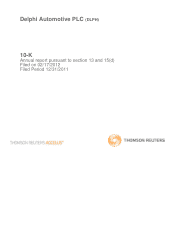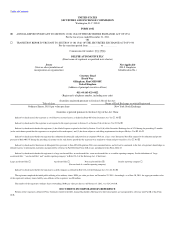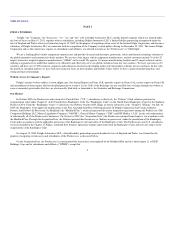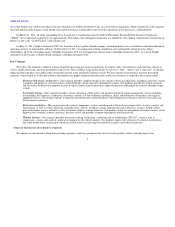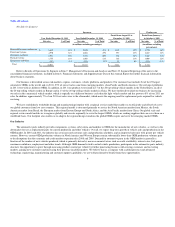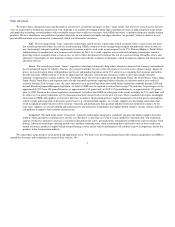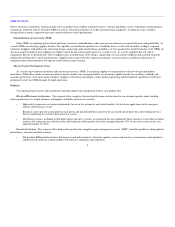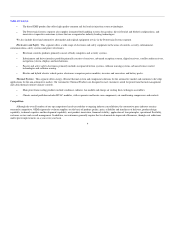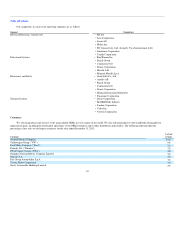DELPHI 2011 Annual Report Download - page 8
Download and view the complete annual report
Please find page 8 of the 2011 DELPHI annual report below. You can navigate through the pages in the report by either clicking on the pages listed below, or by using the keyword search tool below to find specific information within the annual report.
Table of Contents
We believe that continuously increasing demands of society have created the emergence of three "mega trends" that will serve as the basis for the next
wave of market-driven technology advancement. Our challenge is to continue developing leading edge technology focused on addressing these mega trends,
and apply that technology toward products with sustainable margins that enable our customers, both OEMs and others, to produce distinctive market-leading
products. We have identified a core portfolio of products that draw on our technical strengths and align with these "mega trends" where we believe we can
provide differentiation to our automotive, commercial vehicle and aftermarket customers.
Safe. The first mega-trend, "Safe," represents technologies aimed not just at protecting vehicle occupants when a crash occurs, but those
that actually proactively reduce the risk of a crash occurring. OEMs continue to focus on improving occupant and pedestrian safety in order to
meet increasingly stringent regulatory requirements in various markets, such as the recent proposal by the U.S. National Highway Traffic Safety
Administration to mandate rear view cameras in all vehicles by 2014. As a result, suppliers are focused on developing technologies aimed at
protecting vehicle occupants when a crash occurs, as well as those that proactively mitigate the risk of a crash occurring. Examples of new and
alternative technologies are lane departure warning systems and collision avoidance technologies, which incorporate sophisticated electronics and
advanced software.
Green. The second mega-trend, "Green," represents technologies designed to help reduce emissions, increase fuel economy and minimize
the environmental impact of vehicles. Green is a key mega-trend today because of the convergence of several issues: climate change, higher oil
prices, increased concern about oil dependence and recent and pending legislation in the U.S. and overseas regarding fuel economy and carbon
dioxide emissions. OEMs continue to focus on improving fuel efficiency and reducing emissions in order to meet increasingly stringent
regulatory requirements in various markets. On a worldwide basis, the relevant authorities in the European Union, the United States, China, India,
Japan, Brazil, South Korea and Argentina have already instituted regulations requiring further reductions in emissions and/or increased fuel
economy through 2016. In many cases, the same authorities have initiated legislation that would further tighten the standards through 2020 and
beyond. Based on proposed European legislation, we believe OEMs may be required to reduce fleet average CO2emissions for passenger cars by
approximately 20% from 120 grams/kilometer, or approximately 194 grams/mile, in 2012 to 95 grams/kilometer, or approximately 153 grams/
mile, by 2020. Based on the current regulatory environment, we believe that OEMs in other parts of the world, including the U.S. and China, will
be subject to even greater reductions in CO2 emissions from their current levels over the next ten years. These standards will require meaningful
innovation as OEMs and suppliers are forced to find ways to improve thermal management, engine management, electrical power consumption,
vehicle weight and integration of alternative powertrains (e.g., electric/hybrid engines). As a result, suppliers are developing innovations that
result in significant improvements in fuel economy, emissions and performance from gasoline and diesel internal combustion engines. At the
same time, suppliers are also developing and marketing new and alternative technologies that support hybrid vehicles, electric vehicles and fuel
cell products to improve fuel economy and emissions.
Connected. The third mega-trend, "Connected," represents technologies designed to seamlessly integrate the highly complex electronic
world in which automotive consumers live into the cars they drive, so that time in a vehicle is more productive and enjoyable. The technology
content of vehicles continues to increase as consumers demand greater safety, personalization, infotainment, productivity and convenience while
driving. Advanced technologies offering mobile voice and data communication, while minimizing driver distraction such as those used in our
mobile electronics products coupled with global positioning systems and in-vehicle infotainment will continue to grow in importance and be key
products in the transportation industry.
We expect these mega trends to create growth and opportunity for us. We believe we are well-positioned to provide solutions and products to OEMs to
expand the electronic and technological content of their vehicles. We
7

